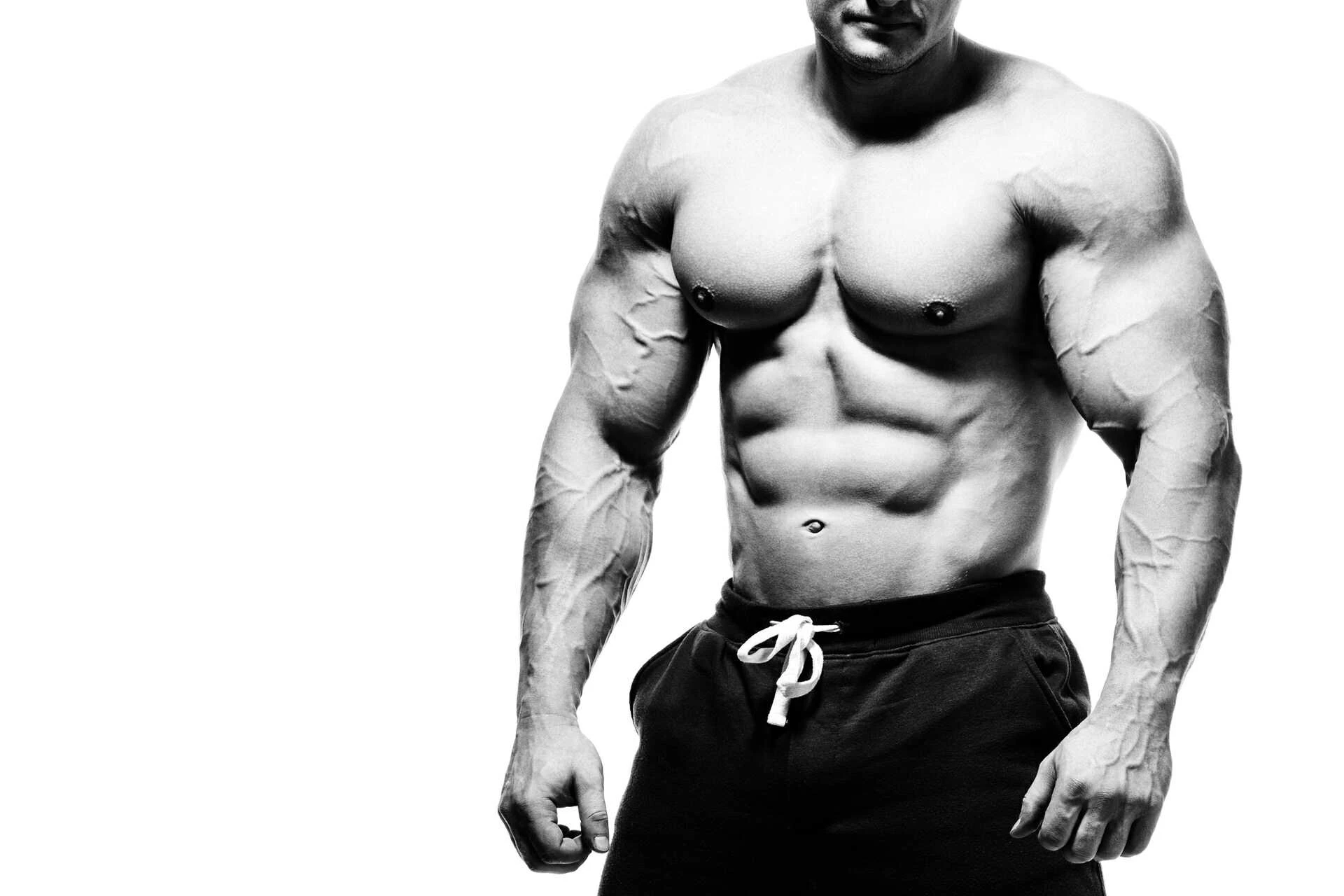Muscle building pyramid

Highlight the most important nutritional and training features for your body's benefit to optimize muscle growth. Learn to build a solid, sustainable approach to fitness!
You must have seen food pyramids before, now meet the pyramid for potential muscle growth! Its simple structure lays the foundations for what you need to accomplish in the process of adding muscle mass to your body, and it also offers the structure you need to prioritize.
Each level of the pyramid builds the next. What does it mean? By jumping to the higher levels without creating the lower two, you will end up feeling only pain, stress and confusion. You have to follow all the steps in sequence, although this will take a long way to go. You must strive for true potential.
With our help, you can start building your pyramid and go your own way and up!

Level 1. Training
Muscle growth always starts with well-built workouts, so the base of the pyramid focuses on the training variables associated with muscle growth processes. These are the factors that allow you to build an effective program and create the stimulus your body needs to make a difference!
These workouts include free weight exercises, multi-joint exercises. Single-joint exercises, like the seated leg extension or cable machine convergence, have their place, but they should not be central to your muscle building plan. Multi-joint exercises (bench press and squat) help you gain much more muscle mass and give your body more stimulus to grow. In addition, exercising different versions of free weights improves anabolism better than exercising on machines.
Use the right training intensity. Scientists have determined that most people should exercise 70-85 percent at one repetition in order to provoke an optimal hypertrophied response. Choose a weight that allows you to do 6-12 reps in good shape until you fail.
Add volume
More volume and multiple sets in sequential order have been shown to be superior to single sets when it comes to building muscle. This is one of the reasons why advanced athletes often follow these tactics. Don't build up volume, but do the same exercises with different tools. Vary your angles, set ranges, and weight types.
Exercise to the point of exhaustion part of your time. Sure, you can grow without climbing to the point of failure, but some movements don't do well. Everything is performed equally if you train to exhaustion, especially when doing isolation exercises on small parts of the body, such as arms and calves, you will not get the same anabolic stimulus as if you stick to your last few difficult reps.
Stick to periodic rest. For bodybuilding purposes, moderate rest intervals of about 60-120 seconds between sets will maximize the hypertrophic response. Resting too long has been shown to be counterproductive to stimulate muscle growth as it reduces the overall accumulation of metabolic stress, a marker of hypertrophy. The smaller the muscles and the easier the movement, the less rest you need.
Lift weights with the right technique. Don't take this process for granted! He supports everything else at this level. Exercise won't work for you the way you want it to if you don't do it well enough. Wait for feedback if necessary.
Level 2. Nutrition
If you constantly change the direction of your training, it gives your body a great boost to growth. But without the right diet, you won't be able to gain the muscle you need!
Eat enough. If your goal is to add mass, then you need to eat more calories daily than you use. They don't have to be much larger. You can get a 250-750g increase in weight every week or about 1-3kg per month without adding significant body fat. This results in an increase of about 300-500 calories daily in excess of your calorie intake. Watch closely to see if your body weight is increasing within your target range.
Eat enough protein. You will hear millions of different versions of how much fat or carbs you need. So let's focus on something that cannot be disputed: you need adequate protein to grow! Protein is essential for building and repairing damaged muscle tissue during hard workouts. Recommendations vary, but the commonly known amount, which will also not burden the body, is 0.5 g per kilogram of body weight daily, divided into several stages of intake, at least 20-30 g.
So how are you going to do this?
"The easiest way to increase your protein intake is to make it a priority nutritional component, which means you always have to have it on hand". "I prepare all my protein sources in advance and always make sure I have my whey protein with me at all times. When I sit down to eat, I already think about preparing the protein for my next meal."
Increase the frequency of your meals. Eat more calories than you burn. Let's say 180g of protein a day is pretty tough for an entire day, divided into three meals. Supplementing your meals with protein shakes and protein-rich snacks every 3-4 hours will help maintain the rate of protein synthesis while reducing increased protein breakdown.
Control your incontinence. You don't have to be cheat mil if you want to build muscle. But let's face it: Of course, it's hard to eat the right food 24/7 and gain weight, simply because low calorie foods won't always make you want to eat them, especially in large quantities. So it's okay to relax a little from time to time! Just do it on an intense training day and still focus on your protein intake.

Level 3. Advanced Growth Techniques
You are already exercising right and even eating right. It's great! You are on the right track. Let's take a look at some more factors that could make the difference between typical results and significant ones.
Include progressive loads. Progressive loading means constantly taking your body to a new level of performance. It has to adapt to every complication you set in front of it. You can do this in a variety of ways: lift more weight, rest less, do more reps, do different movements, and that's not the limit. Never stay in your comfort zone and never stop pushing yourself to do more.
“Constantly increasing your potential is a never-ending process”. "Once you get the hang of it and get used to the stress, you stop growing. Don't be afraid to try new challenges and always try something new. As soon as I feel like I'm in my comfort zone, I reevaluate my goals. If you don't have a significant goal, you'll be in your comfort zone very quickly. "
Use intense techniques. All of these training methods involve exercising to the point of exhaustion. We don't recommend doing them all at once or in every set, but once you put them into your workout routine, they can definitely help you move to the next level.
What about techniques?
-Forced Reps: Since you are training to muscle collapse, your partner should provide you with enough help to control the weight you lift 2-3 reps.
- Drop sets: After you reach muscle failure, quickly reduce the weight by about 25 percent, and immediately continue to the second point of muscle exhaustion.
-Negative reps: Instead of lifting the weight, lower it slowly over 3-5 seconds. Your partner then lifts the weight back to the starting position. This works because you are straining your muscles more, lowering the weight than lifting it.
Use supplements that improve the quality of your workout. Certain supplements are good for building muscle, often because they can help you train harder and avoid fatigue.
Here are a selection of the four most powerful:
- Creatine for strength / muscle growth when used in conjunction with strength training.
- Caffeine can eliminate fatigue during all types of workouts.
- Branched Chain Amino Acids help accelerate recovery from a tough workout.
Whey protein should be a staple of your dietary supplement. It stimulates muscle protein synthesis and leads to significant increases in muscle strength and mass.
Time your nutrient intake correctly. When building muscle, pre- and post-workout meals are the most important goals. Make sure both phases have adequate protein, but also carbohydrates, which will aid in getting more power in your intense workout and recovery process. Fats are less important for these parts of your meal, so focus on them at other times of the day.
Level 4. Recovery
Even if you are already at the very top, do not think that the recovery process is no longer important to you! It's very important to get back to the gym and feel good about preventing mindless workouts. Skip this step and you will immediately feel the failure!
Don't limit your sleep. Sleep is much more than just relaxation. This is the time when your body releases the hormones to heal all the benefits of exercise and get stronger. Most people need seven hours of quality sleep every night. Make this one of your top priorities.
Take a break from exercise. Part of this should be part of the training plan, but part of it depends on you! If you are serious about building mass, but you also do other sports intensively on a regular basis, chances are you are not making every effort to build your muscles. It is very difficult to maximize muscle growth when you squeeze yourself out in other physically challenging activities.

What athletes says?
"In order to build muscle, you must train to the max and let your body repair itself". "For this reason, the rest is absolutely necessary. I hate resting as much as possible, but I know it is necessary to continue building muscle."
Use supplements for recovery. Experienced athletes often take a double approach to supplementation: those that increase training intensity and those that enhance recovery. Make no mistake: they both have to go hand in hand. “My key recovery supplements are glutamine, protein with carbohydrates, BCAA and electrolytes,”.
Choose the intensity of the cycle. You don't have to shy away from challenging workouts or programs. But exercising nonstop for months on end is likely to do as much harm as it does good. Cycle through periods of low intensity and high intensity training. Take a break from even being in the gym, for both physical and mental health.
Build your new self from scratch
Muscle growth requires a lot of dedication, but also a lot of foresight and strategies. Don't ignore quality workouts that you are perfectly capable of doing, coupled with proper diet and recovery. Build yourself a solid base and you will quickly surprise yourself with what you can achieve.